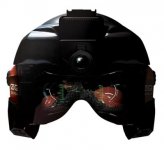How do you help hypersonics keep their cool? Make them sweat.
RTX researchers validate ’transpiration cooling’ in a test for DARPA
The problem has perplexed scientists for years.Hypersonic missiles can dart through the atmosphere faster than a mile per second. But at those speeds, things get so hot that many materials would melt – including those most likely used for the tip, or, as it’s sometimes called, the leading edge.
“You go from something sharp to something kind of rounded,” said John Sharon of the RTX Technology Research Center,
“and when you go from sharp to rounded, you increase your drag, and you end up slowing the vehicle down, which impacts how fast and far we can fly.”
The Defense Advanced Research Projects Agency wants to solve that problem, so they asked researchers around the country for their ideas.
Sharon and his team had one that was simple but intriguing: Make the missile sweat.
Just as humans use pores to cool our bodies, the team sought to show that artificial pores – called transpiration cooling channels – in the tip of the missile could do the same.
“Transpiration cooling has been around for years. Nature has already figured it out – trees use it, and we use our skin,” Sharon said.
“But how do we leverage it for other engineering applications?”
DARPA liked the idea and awarded the research center a contract to model, prototype and test its concept alongside other university and industry teams under what’s known as the MACH program.
“When the opportunity came up, we did some back-of-the-envelope math and said,
‘Does this look like it’ll work?’ and the answer was, ‘Yes,’” Sharon said.
“Then it was really a matter of digging in and doing detailed modeling and simulation.”
Their concept works by placing a compound in the tip of the missile that heats up and generates vapor. The gas is then pushed through thousands of fine transpiration channels – each narrower than a human hair.
Controlling heat in hypersonics
The RTX Technology Research Center has tested a novel method of helping hypersonic vehicles withstand extreme heat. Here’s a rundown of their research project.
At hypersonic speeds, missiles and other vehicles get so hot their leading edges begin to deform
A method called transpiration cooling uses artificial pores to deliver a cooling liquid to the surface
Researchers used predictive modeling and advanced manufacturing to design and build their hardware
The research validated the approach, which can also be used to manage heat for other objects such as aircraft turbine blades
The test article is a wedge-shaped piece of a heat-resistant metal, and it is slightly larger than a credit card. To make the cooling channels as small and efficient as possible, Sharon’s team collaborated with Collins Aerospace, an RTX business, using their expertise in micromachining, an advanced manufacturing method that uses lasers to create intricate parts.
To prove it would work, the team first tested the wedge on a burner rig at the research center in East Hartford, Connecticut.
“It’s essentially a big crème brûlée torch,” Sharon said.
The burner rig aims a torch fueled by natural gas and oxygen at the test article to mimic changes in temperature that would occur at hypersonic speeds. Once the team was confident with the test article’s performance, they conducted more intricate testing at a facility that uses an electrical arc to heat and expand gases to high temperatures and speeds, simulating the conditions of very fast flight.
The tests offered preliminary proof that their concept would work, but Sharon said they’ll need more research and refinements before transpiration cooling is ready for use in hypersonic missiles. The remaining challenges include figuring out how to make the channels even smaller, and determining whether their findings on a credit card-sized test article would scale to a full-sized hypersonic vehicle.
Sharon said he believes what they learned could have applications for several RTX products – including cooling aircraft engine turbine blades – and it showed their predictive modeling was reliable.
“When you’re flying five-plus times the speed of sound, the temperature can rise very quickly – in a fraction of a second,” Sharon said.
“The folks on the team involved with modeling did an awesome job estimating how long the test article would survive.”
Finding answers to questions like this one is why Sharon joined the research center. After earning his doctorate, he saw it as an opportunity to apply cutting-edge research to aerospace and defense.
“Proving that out in the lab has been great,” he said.
“The next step is always trying to say, ’How would a customer adapt this and perform better?’”
This material is based upon work supported by the United States Air Force under Contract No. United States Air Force FA8650-20-C-7001.


